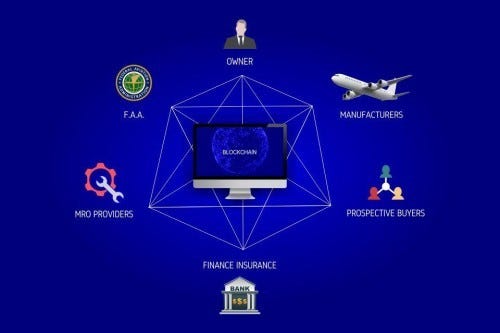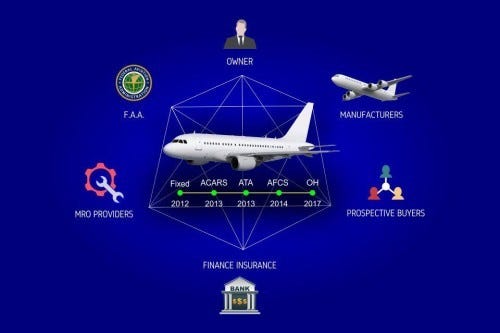Latest news about Bitcoin and all cryptocurrencies. Your daily crypto news habit.
 Photo by Rodrigo Rodriguez on Unsplash
Photo by Rodrigo Rodriguez on Unsplash
Tourism is taking a big leap in the current times as everyone is opting to travel around and explore the world. The aviation industry plays a vital role in travel as flights today have become accessible and affordable more than ever. With over an estimated number of 21,600 fleet in 2017, the aviation industry is expecting a growth of about 43,560 fleet by the year 2037 which counts to almost double the size.
Aviation Industry Issues
The aviation industry, despite of its tremendous growth in the recent times, faces some issues that need to be addressed with the aid of technology. First and foremost, the safety component of the industry needs to be paid attention to as almost 3302 air accidents take place on an yearly basis. These might be a result of inaccurate data logs, lack of maintenance or unconcerned staff.
Let’s have a look at the issues that are affecting the growth of the aviation industry.
Paper binders- The present-day operating structure of the aviation ecosystem involves the usage of paper logs for storing maintenance data or information. In the case of need for repair, the process of checking the past records according to dates gets tedious and cumbersome process. Moreover, the tickets generated in the current system also involve the use of paper which is an unnecessary waste.
Data privacy- Passenger rely on flight systems while revealing their identities and information. Protecting this data is a necessity as leak of such information can lead to trust issues with the system.
Safety- In the aviation ecosystem, the operational integrity and generation of revenues are at stake when something goes wrong along with the safety and security. From identities to data records, everything needs to be secure as their implications result in troublesome situations
Multiple isolated systems- Airlines consist of many individually isolated systems in play such as passenger service and crew management systems. Due to this isolation, the data transfer process between these systems isn’t very smooth. Moreover, individual systems are prone to errors as extracting records from multiple resources increase the probability of redundancy and mistakes.
Dishonest staff/departments- While the recruitment process for aviation is a tough one, there’s no guarantee that it all happens with utmost honesty. There might be instances where pilots may not hold as much experience as they showcase as the flight log records are easy to be forged. Moreover, the chances of corruption for flight schools can be equally questioned as they have the access to change the paperwork in terms of flight hours. On the top of this, operators in the system can also do the dirty work by under-reporting flight hours in order to save maintenance costs.
Enter Blockchain
Blockchain technology can turn out as a saviour for the aviation industry with its features of immutability and security. A blockchain system stores information in the form of blocks that contains transactional data along with its history.
Each block is verified by the process of consensus and sealed in a manner that protects anyone from corrupting or manipulating the information. While the information is highly secure, it is visible for all the participants of the network.
What’s a Blockchain?
- A blockchain is decentralized network which makes it free from the control of any certain single entity.
- All the participants in the network maintain a copy of the blockchain individually which is termed as a ledger.
- Upon adding information to this ledger in the form of a new block, the information is shared throughout the network which keeps all the copies in synchronization.
- As the blockchain network is distributed in nature, it is proven to be more robust and secure than a traditional database.
When it comes to aviation ecosystem which involves multiple subsystems under its umbrella, blockchain turns to be very useful as it allows sharing of the same data transparently between these systems while providing utmost security. A blockchain based platform can create an aviation system that operates on reduced costs and increased data transmission along with new possibilities.
The potential of blockchain can be harnessed by applying the technology to the individual independent operating systems. Many of the operational tasks involved in the aircraft leasing such as maintenance, payments, monetary exchange can be placed on a blockchain and a holistic view of the ecosystem will be obtained.
Consider the concept of a private chain that can be accessed by all the industry stakeholders according to the level of access provided to them as per their authority. This chain could work as a single place for multiple number of activities. First and foremost the tracking of assets involved in maintenance process will be benefitted hugely.
The maintenance logs can be completely transformed and kept on a blockchain which will prevent anyone from the system to modify entries or datasets. Moreover, this stored information can be easily retrieved by the teams to check for past records and plan for future maintenance requirements.
Furthermore, as airlines as well as lease providers are on the same system, smart contracts can be used automate the functions. This automation can be facilitated by associating tokens with physical assets such as an aircraft or any of its parts. Tokens can further be transferred for exchange against digital currencies.
For example, paper tickets as well as e-tickets can be tokenized in the form of an asset through smart contracts in a blockchain. These tickets once associated with the business logic of selling and purchasing, can then be sold by any member of the system in real-time globally.
Along with a mainchain, implementation of side chains is also possible. A side chain will operate along with the main chain and can be used as a single medium to store data for all the interactions within the aeroplane. The main chain will have a reference or hash which will connect it to the information on the side chain.
This will be beneficial as it will protect the main chain from getting overloaded with information. Different chains for each aircraft will allow smooth analysis as an analytics layer can be kept on the top of the system which can combine fleet information of any specific airline and share it through a dashboard.
Moreover, separate chains for each aeroplane would allow specific people to have read or write access. For example, the read and write access to the maintenance information stored on a chain can be shared by the MRO company while the regulators can be provided only with the read access to view the information.
Advantages of Blockchain in Aviation
- All the dimensions of an aircraft can be encompassed in a single-source picture
- All the users in the network have their own ledger copy and which allows access to everyone
- Verified transactions are stored permanently and are protected from loss or change
- Network participants keep their own copy of the ledger as per their jurisdiction which ensures that there are no governance issues in data
- Application of a decentralized database saves expenses and lowers infrastructure and management costs
- Third party contracts can be stored and executed on the blockchain rather than paper or email documents in order to reduce frauds
The revolutionary technology of Blockchain is being adopted in many business processes and companies. Similarly, blockchain when implemented in aviation industry can promote the industry and create new benchmarks.
Though the current use cases of blockchain in aviation can improve the systems and make them more efficient, there are many more yet to be evolved. The adoption of blockchain in aviation will lead to reduced costs, improved management and increased business.
To learn more about Blockchain in Aviation, you can check another article written by me previously here, https://bit.ly/2sRH6k0
How an Airplane System Works With Blockchain was originally published in Hacker Noon on Medium, where people are continuing the conversation by highlighting and responding to this story.
Disclaimer
The views and opinions expressed in this article are solely those of the authors and do not reflect the views of Bitcoin Insider. Every investment and trading move involves risk - this is especially true for cryptocurrencies given their volatility. We strongly advise our readers to conduct their own research when making a decision.

